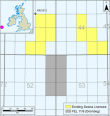Frontier Exploration Licence (FEL 2/14) over the Drombeg Prospect granted to SOSINA and Providence
22 January 2014
The oil potential showed by the Dunquin North well supports planning of a 3D seismic survey that has commenced
SOSINA Exploration Ltd is pleased to provide an update on the Licensing Option 11/9 ("LO 11/9" or "Drombeg"). Providence (80%, Operator) and SOSINA Exploration (20%) were awarded Drombeg as part of the 2011 Irish Atlantic Margin Licensing Round.
The Drombeg prospect lies in c. 2,500 metre water depth and is c. 3,000 metres below the seabed. The 872 MMBO REC (P50) Lower Cretaceous Drombeg prospect is located in the Southern Porcupine Basin, c. 220 km off West Cork, being c. 70 km from the Dunquin exploration prospect which was drilled during 2013.
Providence and SOSINA have recently been awarded a follow-on Frontier Exploration Licence (FEL) 2/14 over Drombeg, having made a mandatory 25% relinquishment of the area. The principle element of the forward work programme is the acquisition of a 500 km2 3D seismic survey over the prospect, with survey planning having already commenced. The main Lower Cretaceous Drombeg prospect is considered to be of a similar age and depositional setting to prospects being targeted by Kosmos Energy further to the north and east in the basin. The recently completed ExxonMobil-operated Dunquin North exploration well, which encountered a residual oil column in an over-pressured carbonate reservoir, confirmed both oil generation, migration and entrapment within the Lower Cretaceous in this part of the basin.
Providence as operator sees the results as very encouraging. In connection to the release the Technical Director of Providence, Mr. John O'Sullivan has made the following comment:
"Given the significant oil prospectivity, which was highlighted during the Licencing Option phase, it should come as no surprise that we have elected to progress Drombeg to an exploration licence. We envisage the 3D survey both as a tool to allow for further exploration risk mitigation, together with well planning. The results of the nearby Dunquin North well confirmed our oil-prone model for the area with the overpressure encountered in that well mitigating top-seal risk at Drombeg. In contrast with the Dunquin North target however, our existing 2D seismic data indicate that active hydrocarbon migration into Drombeg is occurring to the present day."
| Contact: |
Mr. John Ødegaard, Chairman of the Board Mobile: +45 27 26 00 03 |
Drombeg, LO area | About Drombeg
As mapped, the Lower Cretaceous Drombeg stratigraphic prospect demonstrates a significant seismic amplitude anomaly and low seismic impedance as well as a marked AVO (amplitude versus offset) response. Providence engaged Ikon Science to carry out a rock physics modeling and 2D seismic inversion study of the Drombeg prospect using a number of key 2D seismic lines together with regional well data. This study has concluded that the mapped seismic anomaly is consistent with a modeled hydrocarbon bearing sandstone interval which has a seismically derived thickness of c. 200-300 ft. Providence's mapping shows that the anomaly is aerially extensive covering c. 240 km2 and is interpreted to be the deep-water equivalent of Lower Cretaceous Apto-Albian aged shallow water marine sandstones encountered in the BP-operated 43/13-1 well, drilled in 1988. That well, which was situated c. 80 km from Drombeg, encountered c. 70 ft of net Apto-Albian sandstone (average porosity of c. 19%).
An underlying second seismic anomaly has also been identified and modeled to be consistent with hydrocarbon bearing sandstone with a seismically derived thickness of c. 140-200 ft and both anomalies appear to have a potential common down-dip depth termination. The analysis of the primary Drombeg seismic anomaly has indicated a recoverable P50 prospective resource potential of 872 MMBO, based on an oil-in-place volume of 2.970 BBO, together with analogue data from the North Sea.
However, further technical data, including 3D seismic, will be required in order to better assess the ultimate resource potential of the Drombeg prospect. Further similar Lower Cretaceous seismic anomalies have been identified both laterally offset to, as well as vertically stacked with, the Drombeg prospect providing further resource growth potential.
Two separate stratigraphic, but vertically stacked objectives have also been identified in the overlying Lower Cenozoic and underlying Upper Jurassic. The Lower Cenozoic feature is interpreted to comprise a deep-water basin floor fan covering c. 295 km2 and which exhibits marked amplitude versus offset (AVO) anomaly. The deeper Upper Jurassic feature is mapped as a large tilted fault block structure with c. 140 km2 of closure. A notable fluid escape feature has been interpreted at the crest of the Upper Jurassic tilted fault block and which appears to be acting as a hydrocarbon migration path into both the overlying Drombeg Lower Cretaceous and Lower Cenozoic target intervals. |
« Back

